

The first major destination on my trip took me to Toronto. This is Canada's most populous city with about 6 million people living in the greater metropolitan area, or when put another way, about 1 in 5 of the total population of Canada residing in or around the city. Toronto is a highly cosmopolitan city with one of the most multicultural populations in the entire world. People from everywhere come to live in this city and make it their home, enriching it with different languages, customs, and traditions. This helps to make Toronto a center of business, finance, arts, and culture. A large number of Canadian businesses have their headquarters located in the Toronto area, and the city is the home to Canada's major national broadcast networks and media outlets. Toronto is much too large to see in a single day, but I was going to do my best to cover a lot of ground in the 24 hours that I had available on this trip.




I woke up early and began the day by driving from Niagara Falls to Toronto. The route took me along a semicircle around the western end of Lake Ontario, and the distance itself wasn't that far. This drive passes through some of the most densely populated parts of Canada, however, and the traffic can get backed up something fierce when entering the city. I tried to time it so that I arrived just after the bulk of the morning rush hour traffic, and this worked out pretty well. After dropping off my luggage and car at the hostel where I would be staying for the night, I headed out on foot to explore Toronto. The CN Tower was visible immediately off in the distance down by the waterfront, and I would be heading that way later on in the afternoon. To begin my sightseeing, I walked north along University Avenue taking in the sights along the way. There was a new performing arts center for the Canadian Opera Company with a shimmering glass facade, located near several historic homes like the Campbell House pictured above. As one of the major boulevards in Toronto, University Avenue also contained a series of public statues commemorating famous individuals from the past. The most prominent were the war memorials, such as this one to the fallen dead of the Great War between 1914 and 1918. There were also lots of stores and restaurants flanking both sides of the street, with this being one of the most heavily trafficked parts of the city.


At the end of University Avenue lies a green area known as the Queen's Park, the home of the Legislative Assembly of Ontario. This is the home of Ontario's provincial legislative body, a unicameral parliament with 108 seats in total. This particular building dates back to the late 19th century, constructed in 1893 in a Romanesque revival style of architecture. The front of the structure was deliberately designed to be asymmetrical, and the east and west wings also don't match one another. There was a serious fire here in 1909 while part of the building was still under construction that nearly destroyed the entire structure. When I approached on this particular visit, the Legislative Assembly seemed to be almost completely deserted. It was a Tuesday morning in July and the parliament was not in session. This didn't appear to be a major tourist attraction.

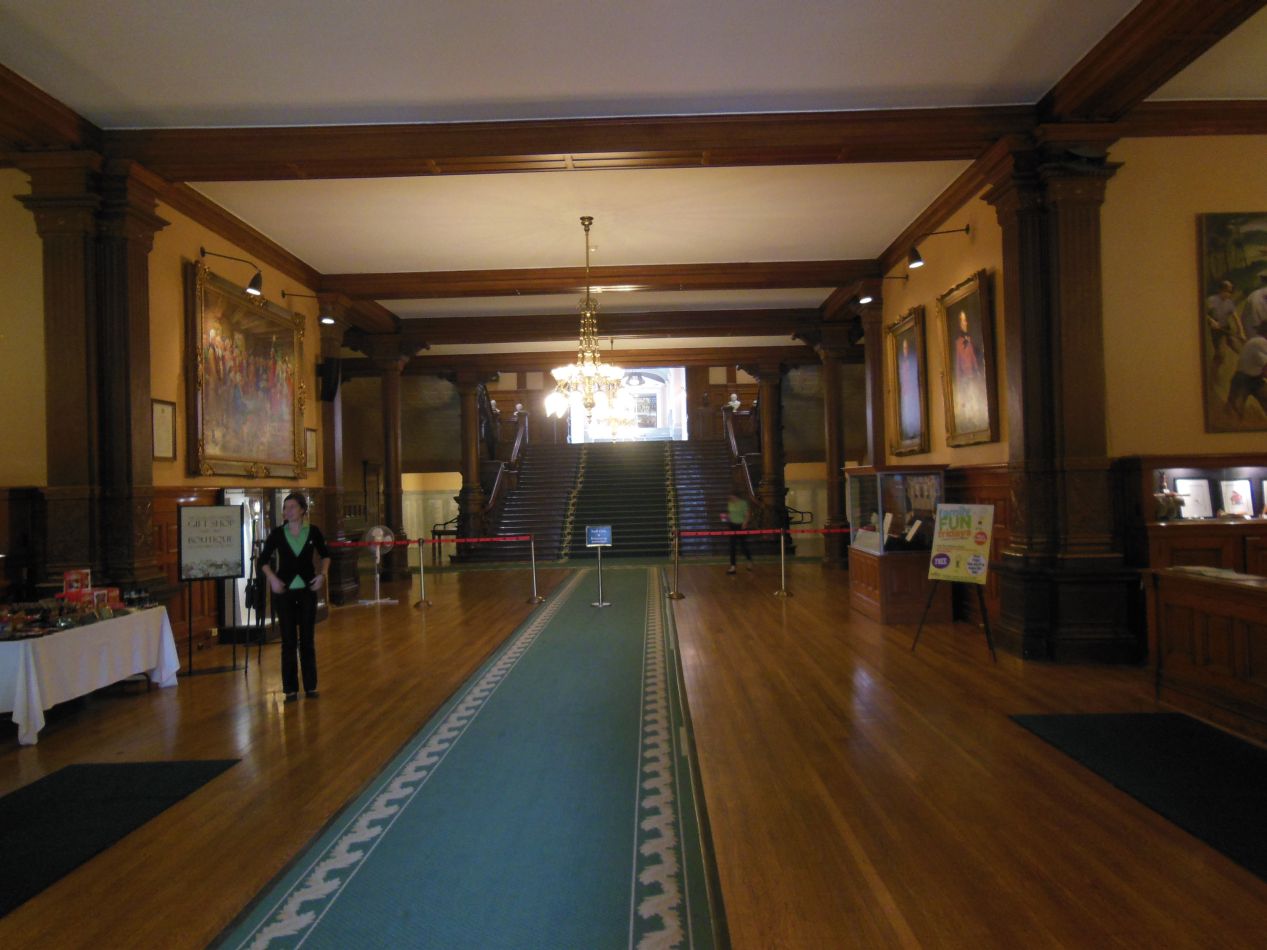


I didn't end up having to wait for a tour group inside; since there was no one else around, one of the guides inside the building simply walked me around immediately on what became an effective private tour. (You may have heard that Canadians are polite people and the stereotype has been true in my experience.) The highlight of the tour was the legislative chamber itself, with a setup that imitated the Canadian parliament at the federal level in Ottawa. The design of the legislative chamber was based off of the British model, naturally, with seats placed on two opposing sides of the room for the government and opposition, and with a chair in the back reserved for the monarch's representative. This is noticeably different from the semicircular design used in the United States and many other republican forms of government.
Elsewhere in the building, the western wing of the Legislative Assembly switched from wood paneling over to a Neoclassical design with lots of white marble. This area contained a number of historical artifacts, with the most interesting one being the ceremonial mace used to open sessions of the assembly. The original mace dating back to 1797 had its own display case, along with an impressive history behind it. This mace was stolen by American soldiers when the fledgling town of Toronto was burned to the ground in 1813. It was held in the United States for more than a century as a war trophy of sorts before Franklin Roosevelt returned it back to Canada in 1934. The current ceremonial mace that dates back to 1867 was also on display here, and it was a lot more gaudy than the humble initial effort of a century earlier.

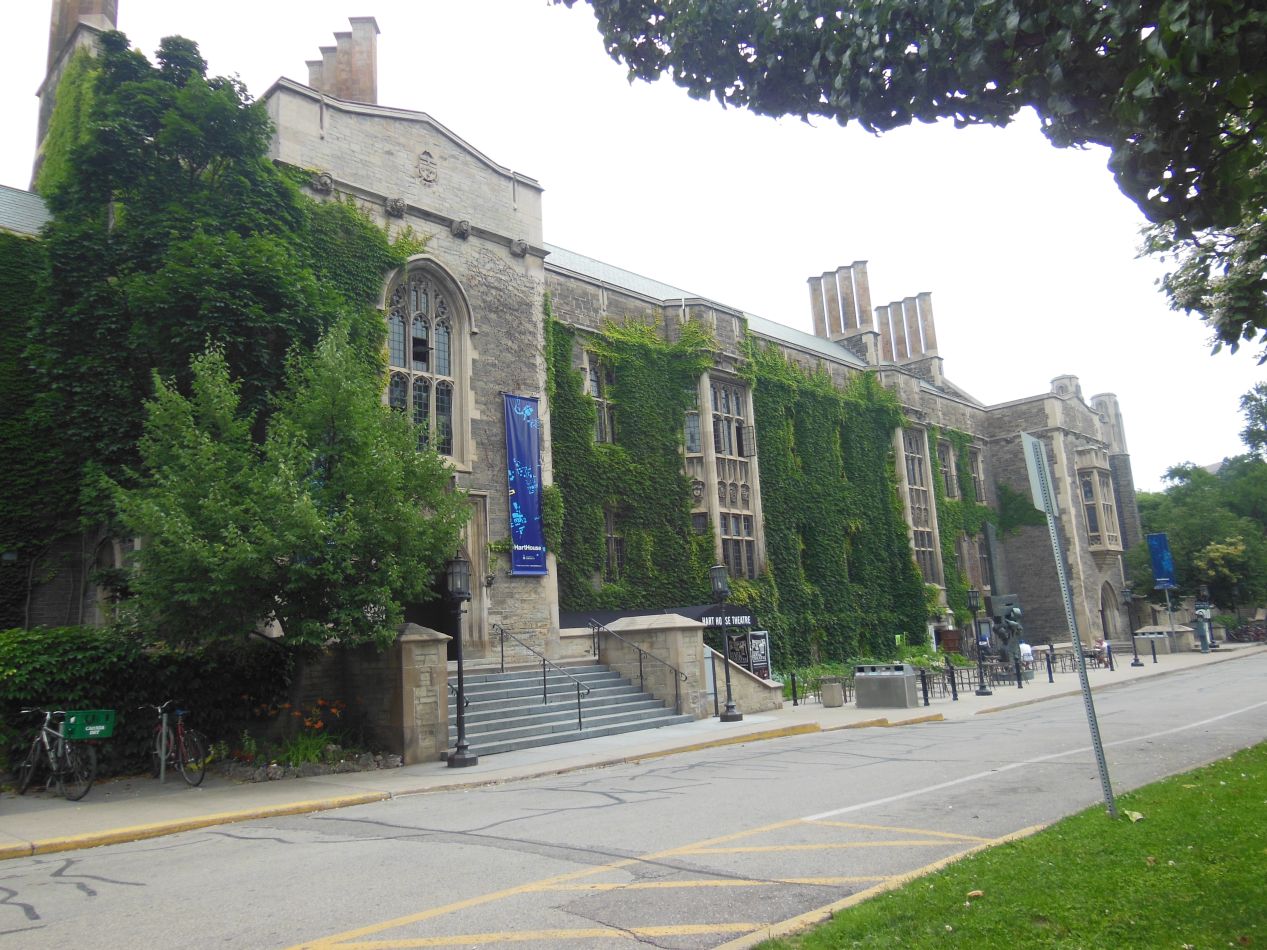


Just to the west of the Legislative Assembly of Ontario was the campus of the University of Toronto. In fact, the assembly building was actually located on land owned by the university, which is amusingly renting it to the Legislative Assembly for 999 years at a rate of $1 per year. The University of Toronto is one of the oldest institutes of higher learning in Canada, dating back to an initial founding in 1827 under the name King's College. It's also one of the largest universities to be found anywhere, with more than 60,000 students and 2500 members of the academic faculty. The university has a lovely campus of old stone buildings, including plenty of ivy growing on the exterior. As one might expect this is among the most prestigious universities in Canada, and the Wikipedia page lists three Governors General and four Prime Ministers of Canada to go along with ten Nobel laureates that have been educated at the University of Toronto. I wasn't here to see anything in particular and simply enjoyed wandering around the grounds a bit. I always enjoy visiting colleges and universities to compare their individual setups to my experience with the University of Maryland.

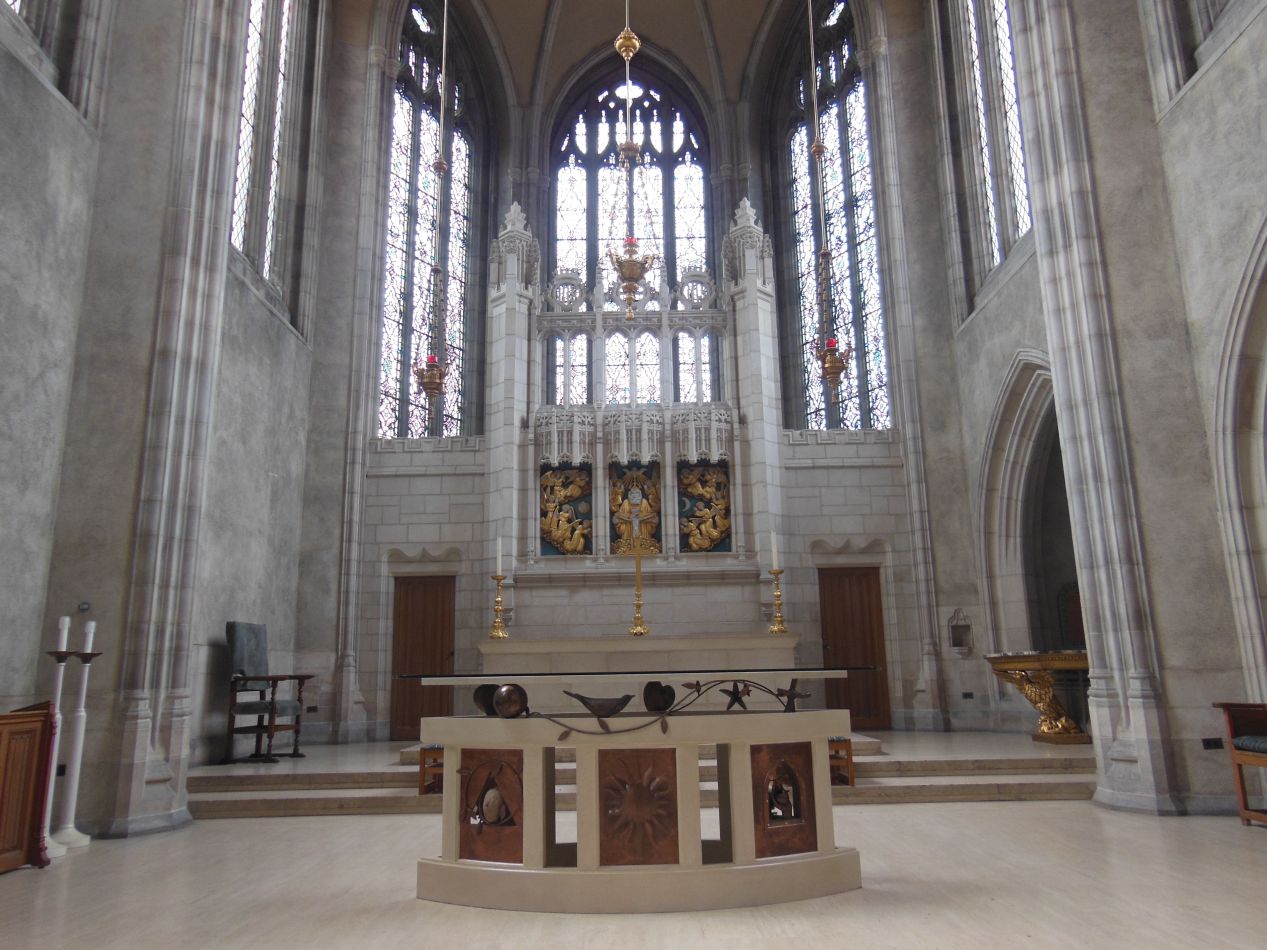


These were pictures of the Trinity College Chapel on the campus of the University of Toronto. Trinity is among the oldest colleges at the university and has a strong attachment to the Anglican Church, with the goal of imitating the Oxford and Cambridge traditions as much as possible. This chapel dates back to the early 20th century and reflects a Gothic cathedral in miniature. I liked the stained glass windows behind the altar, which seemed to be almost entirely made from white glass and gave the interior a bright feeling. Outside there was this beautifully designed central courtyard with the grass cut into strange geometric patterns. As usual, it was quiet and deserted when I visited these locations, with classes out of session for the summer and few students around. I think that if you were to design the Platonic ideal of what a college campus residence should look like, it would be pretty close to this courtyard at Trinity College.

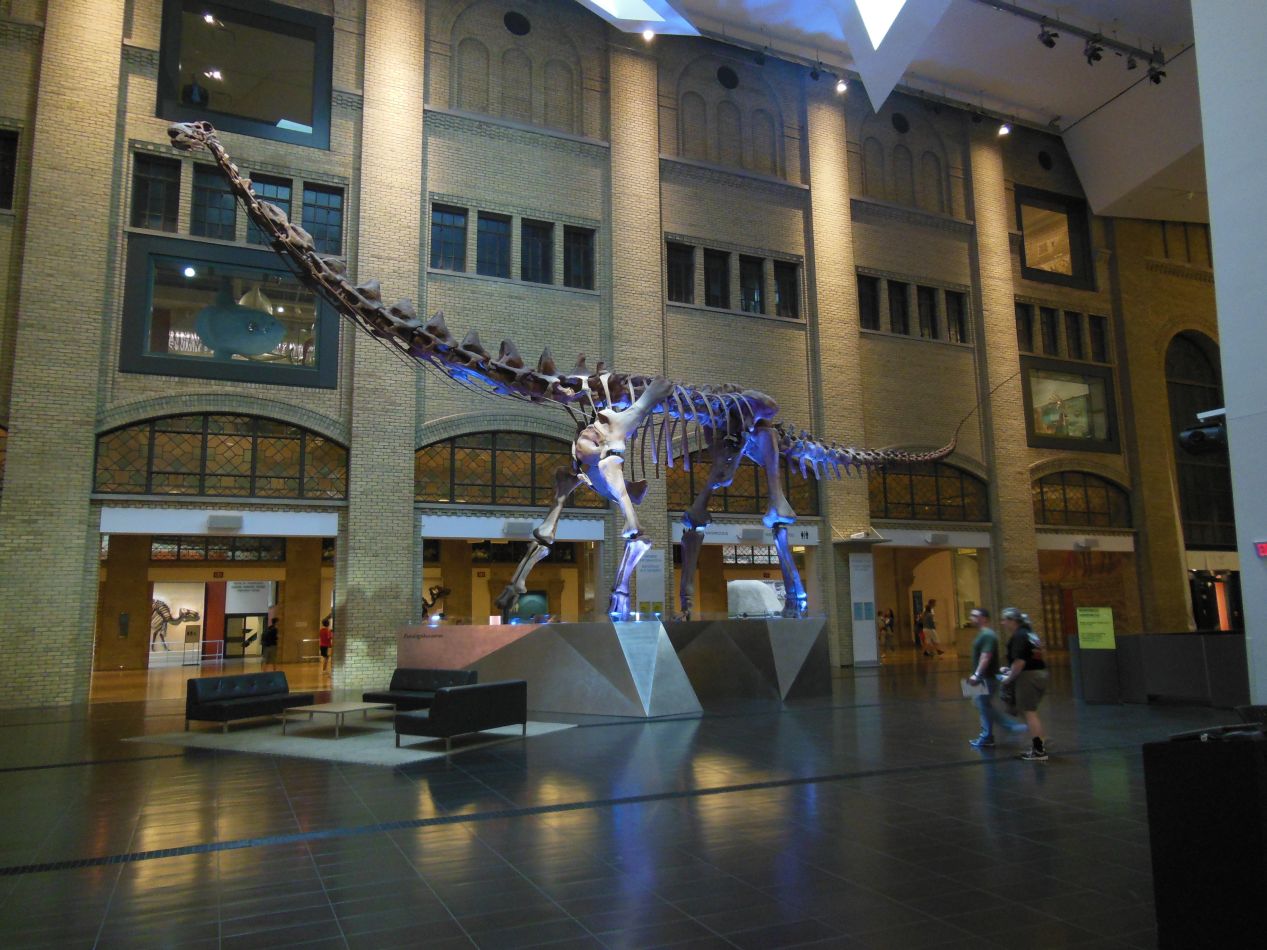


The University of Ontario was located only a short distance away from my next stop at the Royal Ontario Museum. This is one of the largest museums in North America and the most visited museum in Canada, with more than a million people arriving each year to view the collections. The Royal Ontario Museum (abbreviated ROM everywhere inside) holds both art and cultural artifacts as well as displays related to natural history. It has more than 6 million artifacts in total and, as the picture above suggests, has a reputation for having one of the best collections of dinosaur fossils anywhere in the world. The Royal Ontario Museum was founded in 1912 and has repeatedly expanded in size in the century since opening in order to showcase more of its collections, with the most recent addition being the funky entrance hall with its crystalline exterior that dates to 2007. The older parts of the museum, such as the third picture displayed above, looked more like the traditional design of a natural history museum. I would be spending the next few hours here exploring the different galleries and taking pictures of some of my favorite artifacts. There was only one real disappointment: the "Stair of Wonders" proved to be a completely ordinary staircase to the upper floors. What a letdown. 

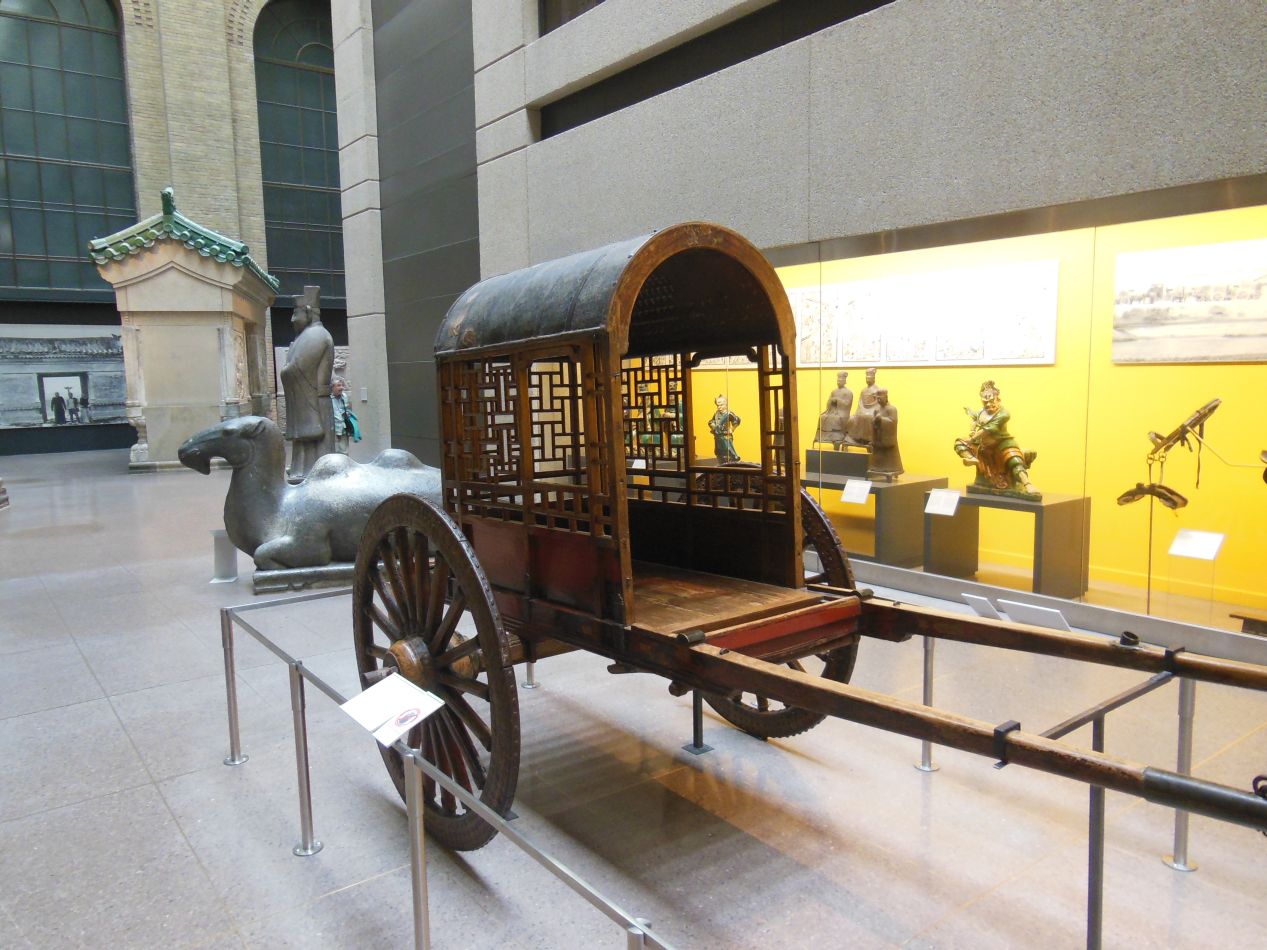


On the cultural side of things, the museum had extensive collections from different parts of the world. There was a full pavilion that looked to be of Chinese design in the East Asia section, along with a rickshaw that had been used to transport passengers. The city of Toronto has a substantial East Asian population and it has been home to many immigrants from China, Japan, Korea, and other nearby areas. In other galleries there were many displays related to the First Nations of Canada, the indigenous peoples who had population the land prior to the arrival of Europeans. The picture above was showcasing some of the artifacts of the Inuit peoples in the far north, but there were other exhibits on other groups throughout Canada, including a full totem pole from a tribe in the Pacific Northwest. Then there were other collections related to South Asia and the Near East, such as the armor of a Mughal warrior from early modern India displayed above. This had particular relevance to me since my dissertation research involved a related Islamic state in southern India, although my work had been focused on Mysore and not the Mughals. Close enough, perhaps. There was a lot more stuff that I could have added here, as I have more pictures from the museum than I care to write about.


The Royal Ontario Museum also had a copy of one of the most famous paintings in British imperial history, Benjamin West's "The Death of General Wolfe" from 1776. This extremely famous painting depicts the death of Wolfe following his victory at the Battle of Quebec in 1759, thereby securing the conqest of New France for Britain during the Seven Years War. It's an overly romanticized and not even remotely accurate depiction of the events that took place, but it was a highly successful work of imperial propaganda and spawned dozens of imitators who produced their own derivative paintings of similar events. This was an original version of the painting by West himself, but it was popular enough that the artist painted it five times in all, with this one being the last version. Regardless of that fact, I still loved having a chance to see one of the original versions of a painting that I had often read about and even used in my own teachings about the British Empire. The museum shrewly placed West's painting in the same gallery with later war propaganda efforts, such as these appeals to buy victory bonds from the first world war. They may have been from a much later era but their purpose was much the same thing.

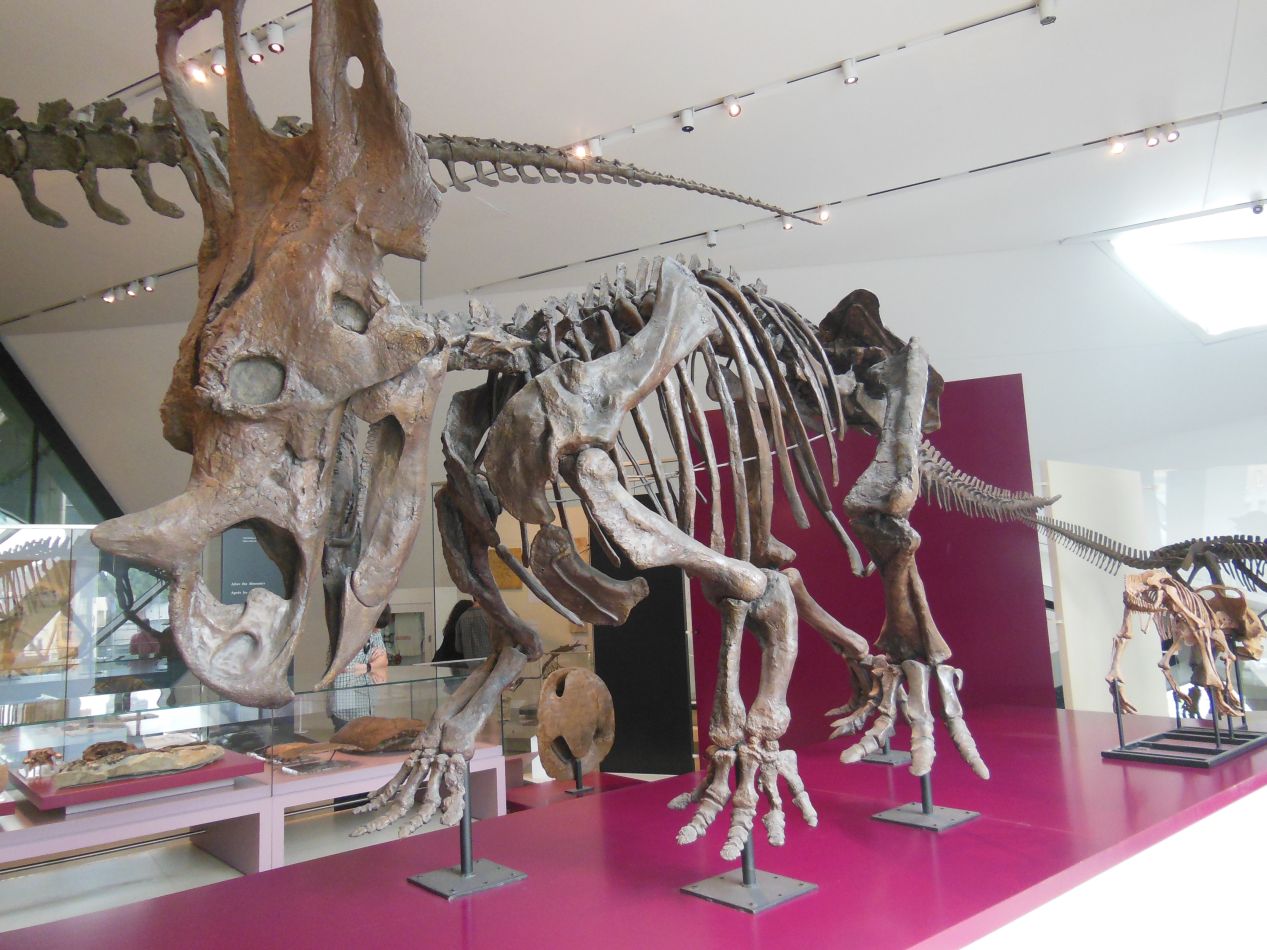


Did I mention that this museum has dinosaurs? The galleries that feature dinosaur bones are the most popular part of the museum, and they were packed with visitors when I passed through. As always, the dinosaurs were especially popular with kids and there were a lot of them here to view the terrible lizards of the past. There were also additional galleries featuring contemporary wildlife like the moose and wolf pictured above, although they failed to attract the same kind of attention from the visiting public.

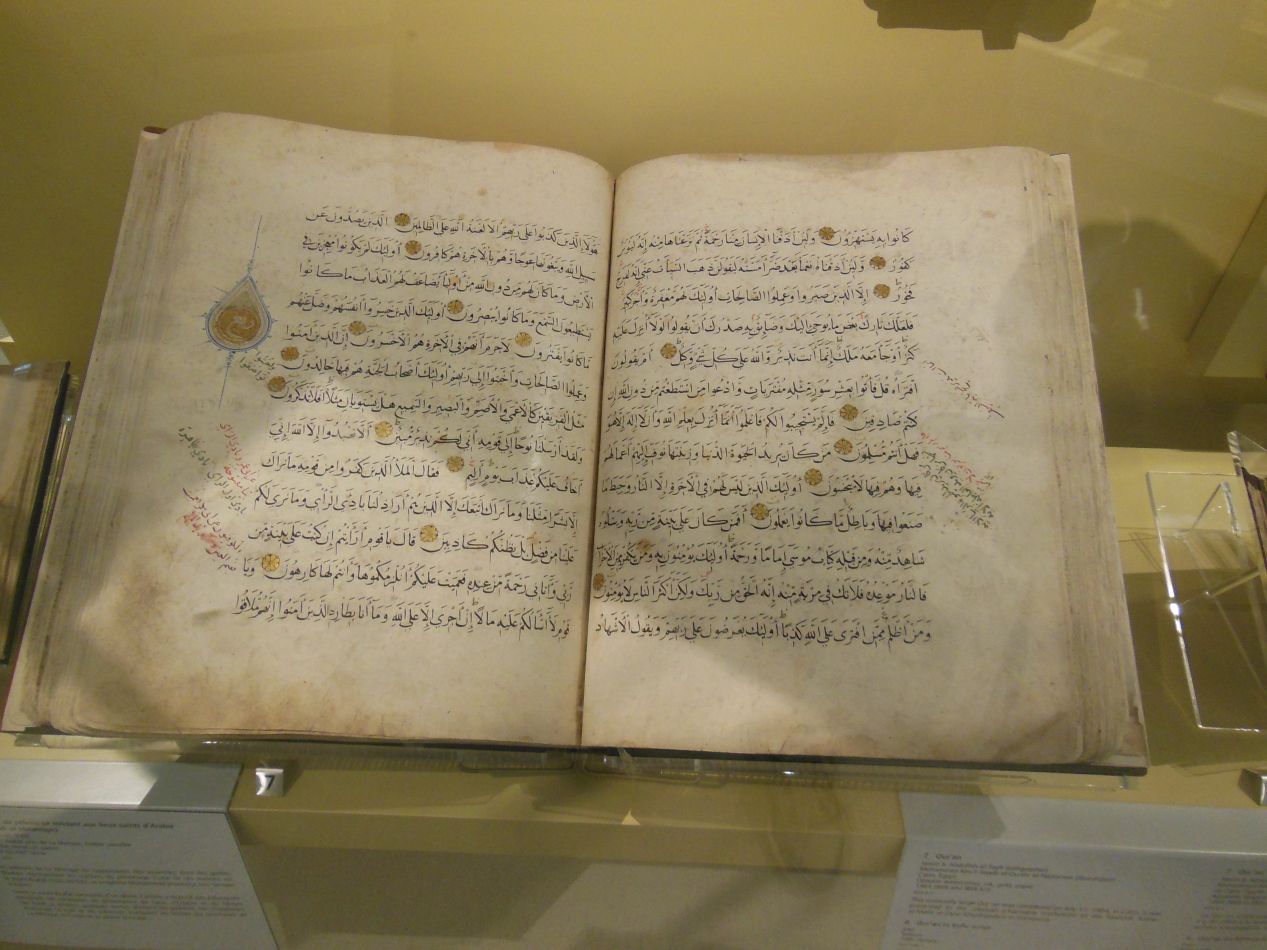


Then there were the other collections that didn't necessarily fit into neat categorization. There was a gallery of medieval arms and armor that also attracted a good bit of attention, which ended with two mannequins in ice hockey attire under the label of "modern armor for sport". Yes, this was Canada all right. Another section held a beautiful handwritten copy of the Quran or Koran, the Islamic holy book. This version dated from the 15th century prior to the advent of printing and had to have taken months if not years to produce. There was also a classical section of the museum that ranged from ancient Egypt up through Greece and Rome, including this display of Roman currency from nearly all of the emperors in the imperial period. The collections of the museum went on and on. I could have spent all day here if I didn't need to keep moving in order to see more of the city. Therefore after about two hours, I hurried on and proceeded towards my next destination.

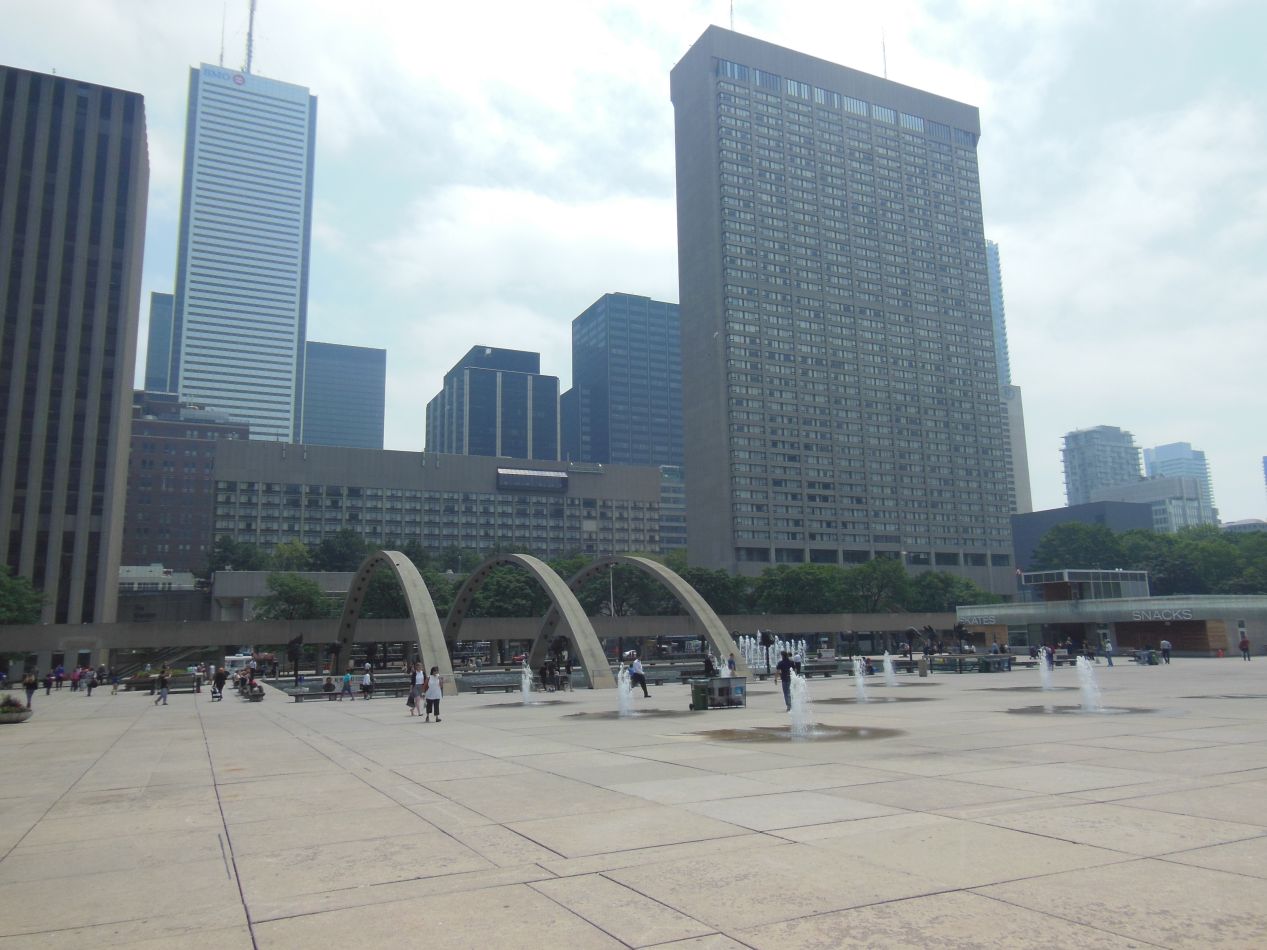


I walked east from the Royal Ontario Museum and then turned south onto Yonge Street. This is another one of the main boulevards in Toronto, and it was popularly considered to be the longest street in the world for a long time due to its convergence with an Ontario highway that stretched for more than a thousand miles. That's not really true but Yonge Street is nonetheless one of the hubs of Toronto, packed with businesses and a mecca for commerce and entertainment of all sorts. The first picture above was a rather poor image of Dundas Square, one of the main public squares of the city of Toronto that often plays host to outdoor events. It's a recent creation dating back only to 1997 as part of a revitalization effort for downtown Toronto. The square is surrounded by billboards and contains lots of nearby shopping and theatres, which has made Dundas Square a major tourist attraction. I had no idea what this was when I was passing through and didn't make any attempt to poke around or take much in the way of pictures. I understand that this place really comes alive at night and becomes Toronto's version of Times Square or Picadilly Circus.
Further to the south and few streets over to the west lay Nathan Phillips Square, the open area with the fountains pictured above. This was an older square dating back to 1965 that also hosts public outdoor events, and in the winter it gets converted into an ice skating rink. It sits next to the statuesque Old City Hall, one of the most prominent buildings in the city and the former host of the Toronto city government. The Old City Hall was designed at the same time as the Legislative Assembly of Ontario, and it shares the Romanesque revial style of architecture. The clock tower rises up just over 100 meters in height (340 feet) and serves as the most distinctive part of the structure. There's another war memorial to the Canadians who died in the two world wars and the Korean War on the street in front of the building. Today the Old City Hall is used as a very stately courthouse building, with the current city hall building located at the northern end of Nathan Phillips Square. The new City Hall building has more of a standard highrise office building complex look to it, and however much more practical it may be, it lacks the style and charm of the older building.

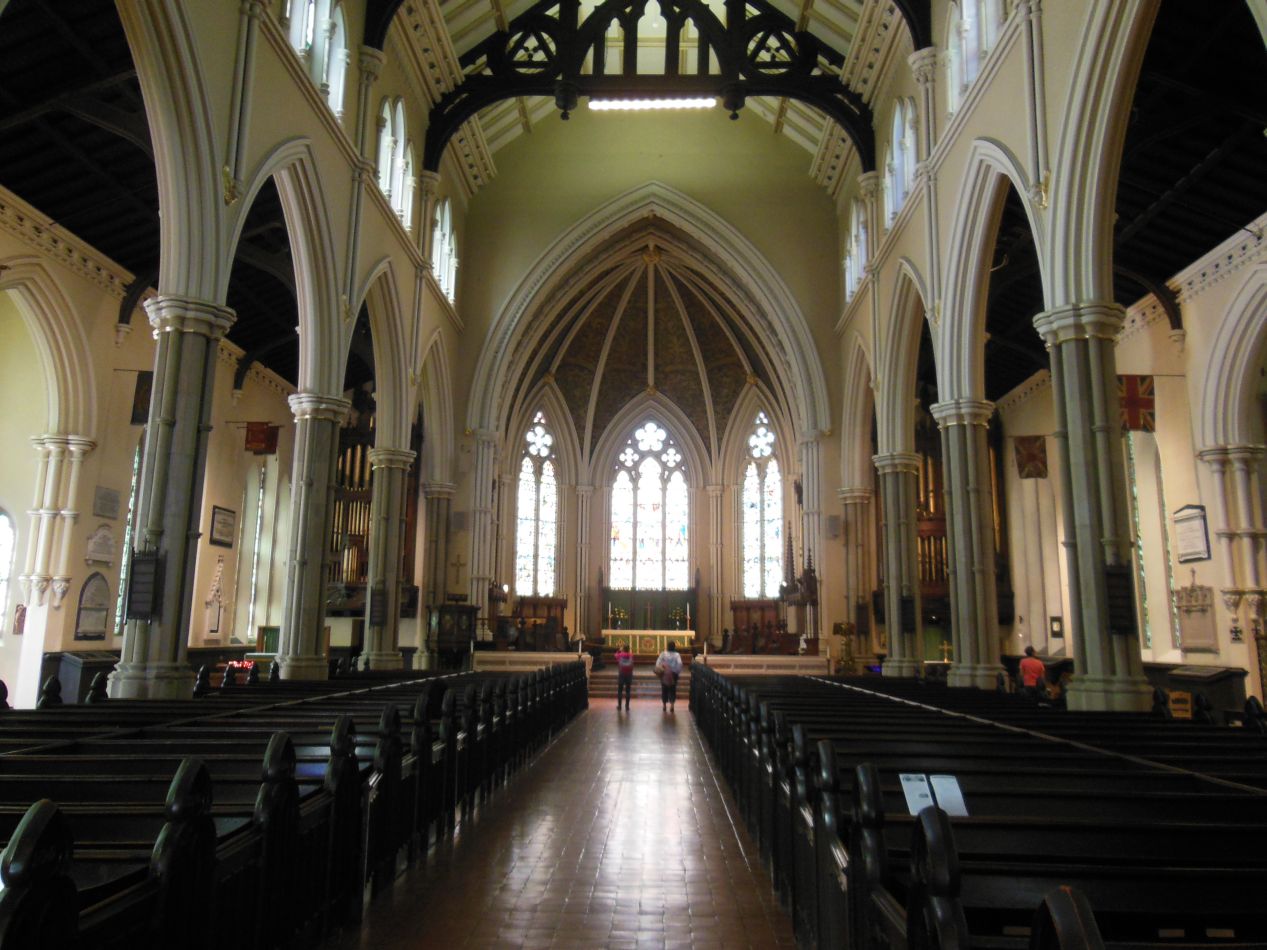


Nearby the Old City Hall was St. James Cathedral, the oldest church in Toronto. This was the fourth church to be located on this spot and carry the name of St. James, with the initial structure constructed in 1803 only to suffer repeated burnings in 1831, 1839, and 1849. Fire was a real problem in an era where virtually everything was built out of wood. The current church was first constructed in the 1850s and has remained as the foremost Anglican church in Toronto ever since. While this building was a little on the small side to be considered a cathedral, St. James had the classic Gothic architectural style with the vaulted ceiling, two rows of stone pillars, and lots of stained glass windows. Modern building materials make it unnecessary to construct flying buttresses on the exterior but St. James Cathedral has them anyway, likely for aesthetic reasons. The interior was brightly lit thanks to the sun coming in from the outside, and there were several regimental flags and banners detailing the history of the military units associated with the city of Toronto. Unfortunately some of the interior pictures were a bit blurry here; I was using an inexpensive camera on this trip that often struggled with indoor photographs. St. James Cathedral was a fairly standard church designed along the Anglican model; I had seen a lot of these during my time in England a few years earlier.

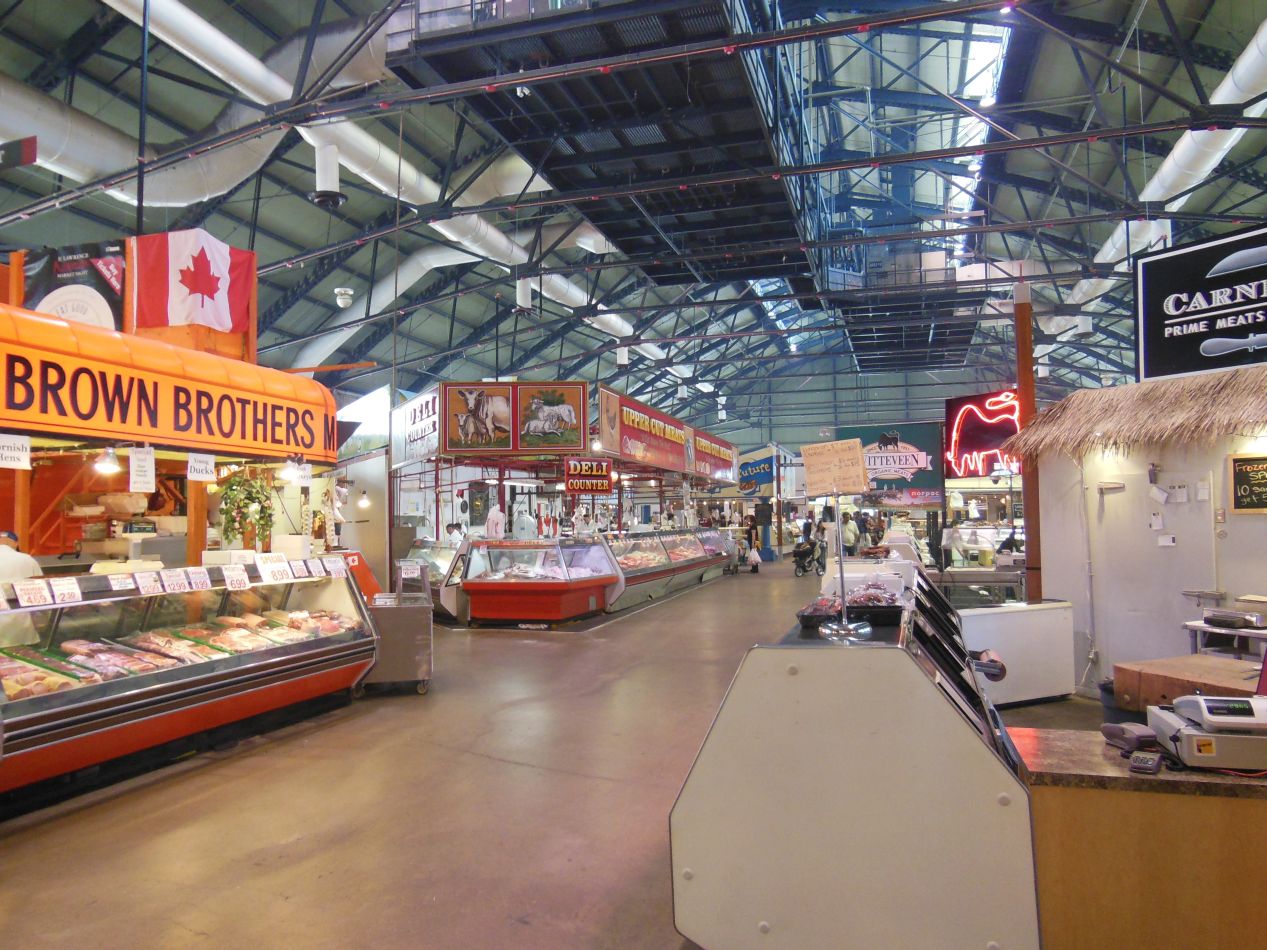


While I was here in the historic part of the city, I also stopped by St. Lawrence Market, the long-serving public marketplace for Toronto. This brick structure was first built in the 1850s as an even earlier version of the Toronto City Hall before being converted into a marketplace in 1902 and then renovated again in the 1970s. Today the building sells fresh food of all kinds specializing in fruits, vegetables, meats, and cheeses. The total floor area is over 100,000 square feet (10,000 square meters) in size and there are more than 50 individual vendors with wares to sell. The food on display looked delicious, especially some of the deli meats that were being offered at excellent prices. Everything was fresh from local producers and sold directly to consumers. It was fun to wander around here and I think that I grabbed a quick snack to eat.

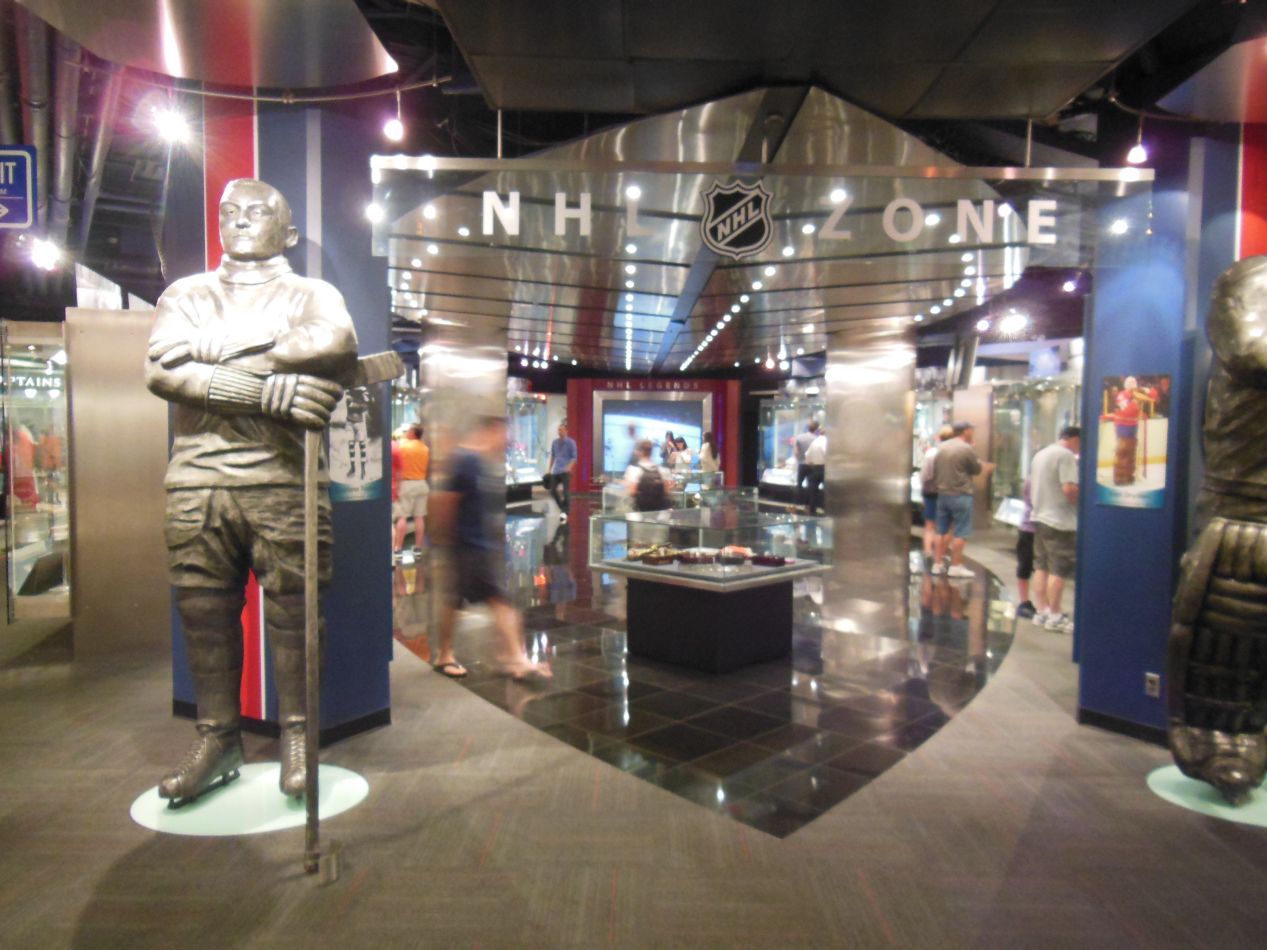


My next destination was located a short distance away in the financial district. The Hockey Hall of Fame is located on the bottom floor of a shopping mall in a former Bank of Montreal building, the kind of place where you would never expect to find a sports hall of fame. It's not hard to find or anything like that, I just couldn't get over my surprise at finding the Hockey Hall of Fame a few stores over from a Starbucks in the food court. Anyway, this is a museum that celebrates everything associated with the sport of ice hockey. The original version of the Hockey Hall of Fame opened back in 1943 and it moved to this current location, which is surprisingly large with 50,000 square feet of exhibition space, starting in 1993. The NHL is unsurprisingly the featured league at the Hockey Hall of Fame, and most of the exhibits focus on North American hockey in some form. While I'm not a huge hockey fan myself, I was enough of a sports fan that I had to spend some time exploring this museum.

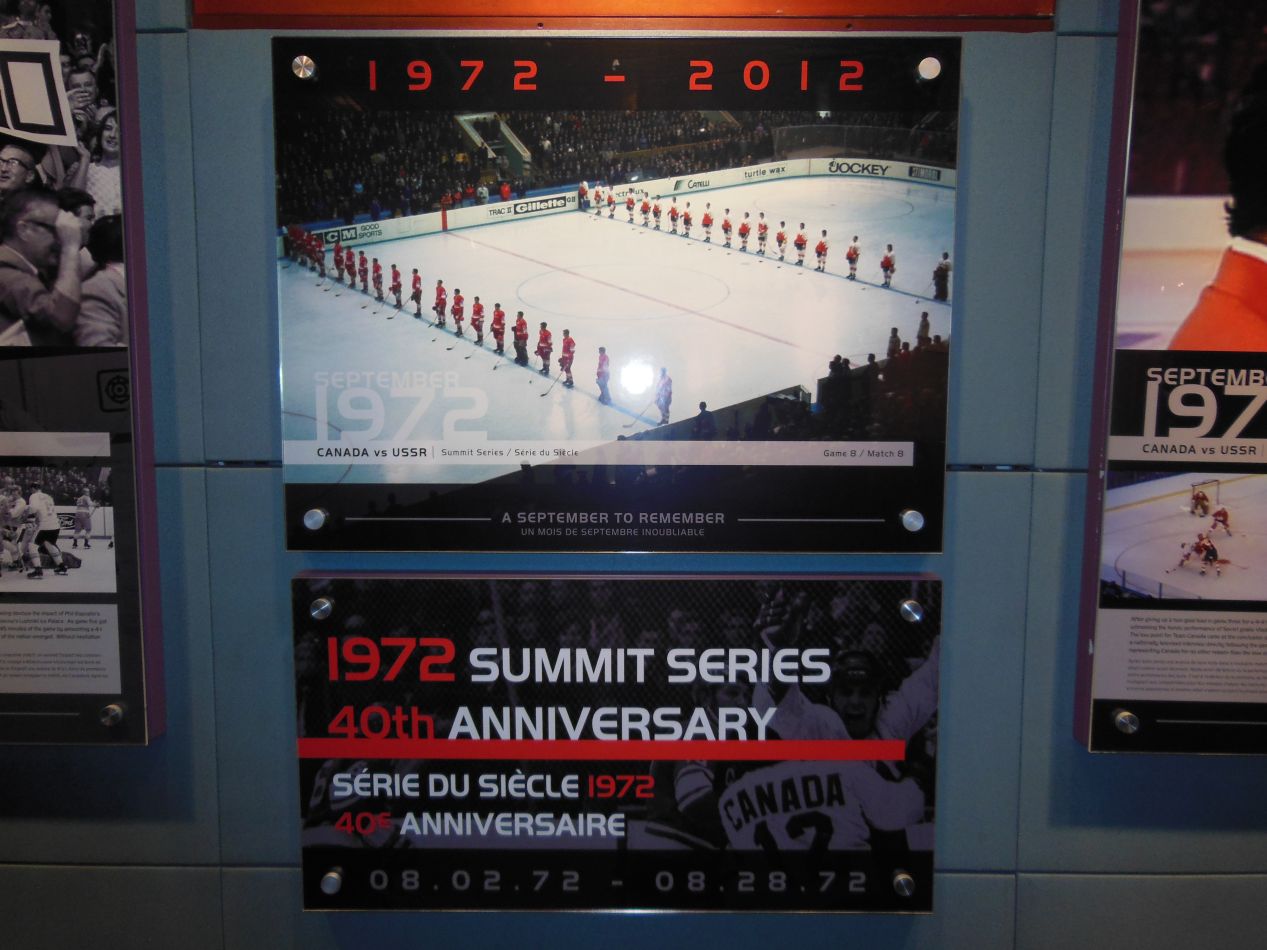


Here's a sample of some of the hockey-related collections on display at the museum. The back area had a series of attractions designed for kids, with the most popular being this one where boys and girls could step out onto the floor and try to score a goal or block a shot as the goalie. There was a long line to try this out the whole time that I was at the Hall of Fame. Other sections had captain's jerseys and small capsule profiles for all 30 NHL teams as well as a gigantic exhibit about ice hockey cards of every kind. Are hockey cards a thing in Canada? I can't recall ever seeing them when I was growing up in the USA. Then there was an excellent presentation with video footage about the 1972 Summit Series played between Canada and the Soviet Union. I had never heard of this before, but it was a huge spectacle in Canada and was sort of a Canadian version of the Miracle on Ice. The highly touted Canadian team was expected to win easily over the Soviets, only to sleepwalk through the opening games and find themselves sitting with 1 win, 1 draw, and 3 losses with three games left to go. Then the Canadians won all three of the final games, all of them taking place in the Soviet Union, all of them by a margin of one goal apiece, taking the overall series by a score of 4-3-1. This was an unbelievable sporting event that non-Canadians have likely never heard about; I'll link the Wikipedia page for anyone who might be curious.
Elsewhere there are parts of the Hall of Fame dedicated to other hockey leagues aside from the NHL, as well as the international competition that takes place at the Olympics. Some of the national team jerseys had amazing designs; I was a big fan of the old Polish team getup with the stylized eagle on the front. Sweden had some really sharp jerseys as well with the three gold crowns on the chest. Then there was a lot of stuff about the Vancouver Olympics that Canada had hosted in 2010, including this station:


On display were the hockey stick, gloves, and the puck used in the 2010 gold medal hockey game between the United States and Canada. This game went into overtime and Sidney Crosby scored the literal golden goal to win the gold medal for the Canadian team. As an American I won't pretend that I was thrilled about this, but frankly most people in the USA had forgotten about this game two days later. For Canadians, this was a life or death event that was watched by 80 percent of the entire country. That's not a typo - virtually the entire nation was collectively watching the fate of their hockey team together. Frankly, the Canadians just wanted it more. They probably deserved to win. The other picture above may well be the single most Canadian sign that has ever been created in the history of the world. If only the sponsorship was from Tim Horton's instead of Pepsi, I think that would seal it. 




Finally, up on the top floor of the Hockey Hall of Fame was the most highly prized part of the collection. This was where the biggest trophies associated with the sport were stored in big display cases, underneath a high ceiling with stained glass in the central dome. One of the coolest things about ice hockey is the unique names applied to the trophies that are given out each year, and all of the historic hardware was on display here. The Conn-Smythe trophy given to the playoffs MVP was here, along with the Prince of Wales trophy given to the winner of the Eastern Conference and the Campbell Bowl given to the winner of the Western Conference. All of that paled in comparison to the biggest hardware, however: this was the permanent home of the Stanley Cup itself. Unlike all of those other trophies, the Stanley Cup is not stored behind glass and sits on a open pedestral where anyone can walk up and view it. It's kind of amazing how casual the Hockey Hall of Fame is about the whole thing. While there were security guards present for safety, they had no problem with visitors coming up and taking pictures next to the cup, even giving it a quick kiss as the players like to do after winning. That's me posing for a picture with Lord Stanley's Cup, as close as I'll ever get to hoisting the trophy. It's one of my favorite pictures that I took from this entire trip - I never thought that I would get this close to the most famous trophy in North American sports!


While we're on the topic of sports here, the Hockey Hall of Fame is only about a block away from the Air Canada Centre, home to the Toronto Maple Leafs of the NHL and the Toronto Raptors of the NBA. I was heading down towards the lakefront, and since the Air Canada Centre was open to the public, I went ahead and walked through the concourse area. While the Maple Leafs and the Raptors are nominally on an equal footing, the reality is that the Maple Leafs are far more popular and likely always will be. Not only is hockey the most popular sport in Canada, the Maple Leafs are one of the Original Six teams in the NHL and have been around since 1917, while the Raptors were an expansion team added in the 1990s. It's not really a fair contest. Unfortunately, the Maple Leafs have been doormats for much of their history and have generally been overshadowed by other teams, especially their hated rival the Montreal Canadiens, winners of more Stanley Cups than any other team. Hope springs eternal in sports though, and there were Maple Leafs signs everywhere in and around the Air Canada Centre.




I finally reached the shore of the lake and spent some time walking along the side of it. Toronto sits on Lake Ontario and it's a fairly significant port city, linking together the Great Lakes with the Saint Lawrence and access to the Atlantic further to the east. The downtown area of the city is located in a natural harbor shielded by a series of small islands in the lake. I was looking out towards those islands in the pictures above, which meant that I didn't have a view of Lake Ontario proper. The Toronto Islands are mostly used today as public parks, with open green spaces, ball fields, walking trails, and even a small amusement park located out on them. There are also several beaches, including a "clothing optional" beach which has to be way too cold to be in use for most of the year. These islands were a location that I would have gone to explore if I'd had more time available to spend in Toronto. With only the single day allotted for this stop, I could only walk along the lakefront boardwalk and snap a few pictures.

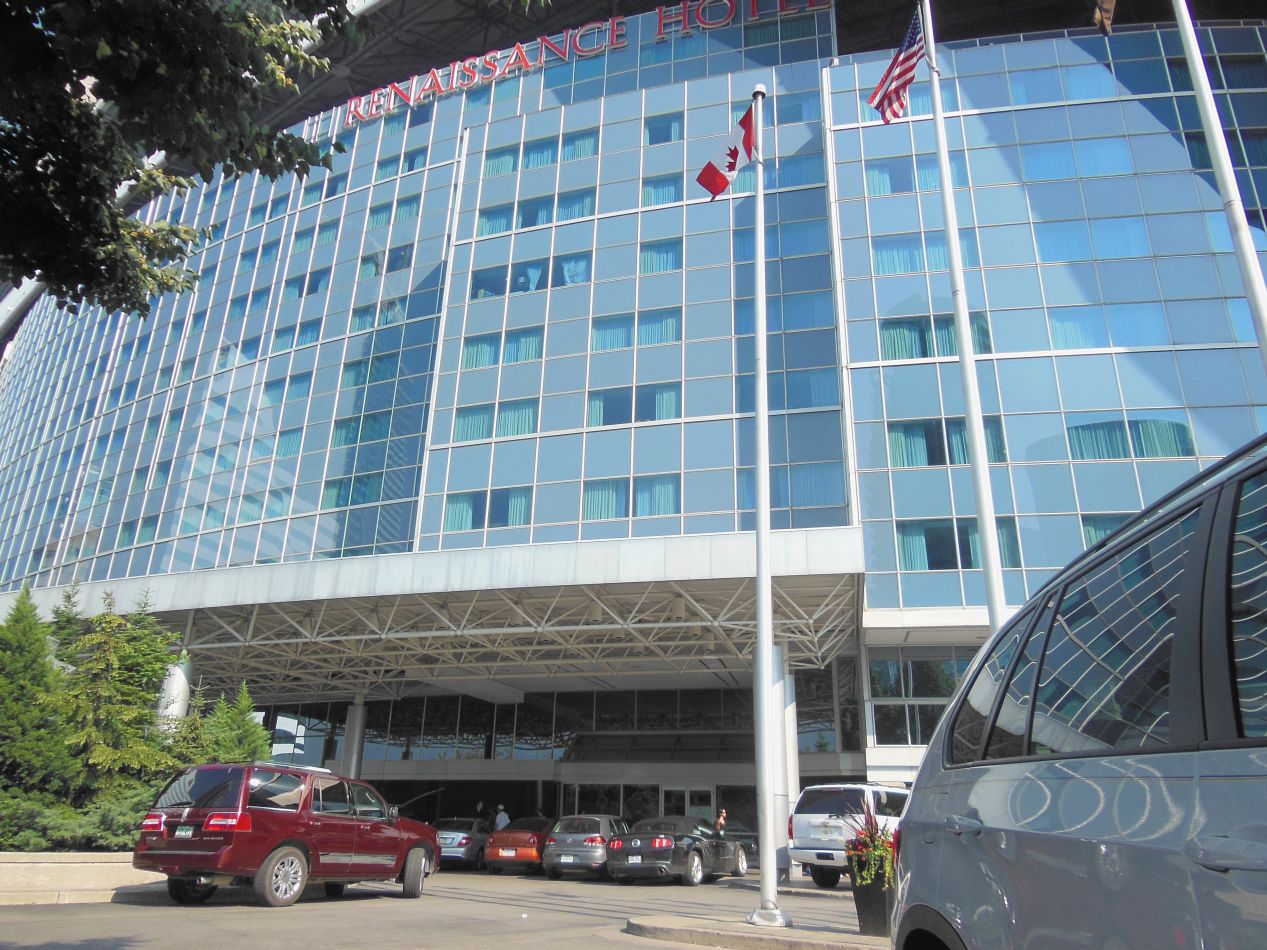


With evening approaching, I was now headed towards the last place that I planned to visit in the city: Rogers Center, home of the Toronto Blue Jays. This stadium was more famously known as the SkyDome before the naming rights were sold to Rogers Communications, a Canadian media company. The stadium opened in 1989 and was famed for having a retractable roof that could be opened or closed as needed, the first of its kind anywhere, as well as a hotel built right into the back of the building. Both of these features are still there, and the Blue Jays never have to worry about having a game canceled since they can close the roof in about 20 minutes if it starts to rain. I took a picture of the hotel at the rear of the stadium, which was owned by Renaissance Hotels at the time. There are 350 rooms at the hotel and the most expensive ones have a private view out into the stadium. Those rooms are not cheap and I had no chance of staying at them.
Rogers Center also sits in the shadow of the CN Tower, which is located practically on top of the stadium. This tower is arguably the most famous landmark for the city of Toronto, and at 553 meters (1815 feet), it held the record for the world's tallest freestanding structure for decades after it was constructed in 1976. (At the time of writing this page in 2017, that record was held by the Burj Khalifa in Dubai at an astonishing 828 meters in height.) The CN Tower remains in use as a communications tower, and its observation deck is visited by more than two million people annually. There's a restaurant with a full bar up there, and even an option for thrill seekers to put on a safety harness and walk around on the OUTSIDE of the tower more than a thousand feet up in the air.  I had gone up there two decades earlier with my family as a kid, and I would have enjoyed taking the elevator ride up to the top again if I didn't need to head into the stadium to watch the Blue Jays game.
I had gone up there two decades earlier with my family as a kid, and I would have enjoyed taking the elevator ride up to the top again if I didn't need to head into the stadium to watch the Blue Jays game.




I was quite familiar with Rogers Center as a stadium. I grew up in Baltimore and I've been an Orioles fan for my whole life, which means that I had watched literally hundreds of games played in this stadium on television over the years. When I visited Toronto as a child, my family also took a tour of the SkyDome at a time when there were no games taking place. As an Orioles fan, I can't stand this team or its stadium, and I have vivid memories of the Joe Carter Blue Jays teams of the early 1990s keeping the Orioles out of the playoffs, as well as the 2016 Wild Card playoff game where the Blue Jays defeated the Orioles here in extra innings. But if I can put aside the fan glasses for a moment, this is a really cool baseball stadium and among my favorites that I've visited in person. The design with the retractable roof and the hotel is completely distinctive, and there's never any chance of mistaking this stadium for anywhere else. The consistent blue color scheme fits the team really well, and I love the fact that the left field and right field fences are exactly 100 meters away from home plate. Perhaps best of all, the CN Tower rises up above the right field stands when the dome is open and creates another memorable image associated with the park. The sight lines are pretty good throughout the stadium, and if Rogers Center lacks some of the amenities of more recent ballparks, it makes up for it with its own quirky charms.




Above are some pictures taken from the outfield looking back towards home plate, and then my view for the game from the upper deck. If you're ever looking for seats that are both inexpensive and provide great views at a baseball game, the seats in the upper deck immediately behind home plate tend to be the best option. This particular game took place on July 2nd 2013, and this was not a great season for the Blue Jays, who finished with 74 wins against 88 losses in last place in the American League East. Their opponent in this game was the Detroit Tigers, and I ended up seeing a crazy start to this match. Doug Fister was pitching for the Tigers and he did not have his best stuff on this day, giving up 4 runs in the bottom of the 1st inning. Fister started out by giving up a single, then hit the next batter, then another single, then a wild pitch, followed by a ground rule double that would have been a triple if it hadn't hopped over the wall. Fister gave up another single and double before managing to get out of the inning. Then it was Blue Jays pitcher Chien-Ming Wang's turn, and despite an easy first inning, he completely melted down in the top of the second. Wang yielded a single, another single, a double, another double, a single, and then a homerun. He was yanked from the game completely after giving up another single following the homerun, lasting only 1.2 innings and giving up 6 runs on 8 hits and a walk. Yikes. Now Fister and the Tigers were ahead 6-4 but they couldn't hold that lead either, with Fister giving up a walk followed by a two run homerun in the bottom of the second to tie up the score at 6-6. This was incredibly bad starting pitching from both teams; Fister threw 40 pitches in the first innning and still had a chance to win the game before blowing the lead in the second inning. Amazingly the game then settled down and became a pitching duel, with the Tigers scoring one run on a Torii Hunter single in the top of the 8th inning and holding on to win 7-6. I had whiplash from the back and forth taking place in this one.


Finally, here are two pictures of the hostel where I stayed for the night, the Canadiana Backpackers Inn. This was a comfortable, cozy place that proved to be quite crowded, and I was glad that I had booked a bed in advance. I'll always remember this place for having a microscopically small parking lot behind their building, and I had to put my rental car through some ridiculous contortions to get out of it the next morning, including driving backwards down an alley to reach the main roads. Good thing I had a small rental car. This was a good place to stay though, and I would recommend it to others looking for an inexpensive place to stay in downtown Toronto.
The next day would bring another new city, as I headed to the national capital of Canada and the city of Ottawa.



